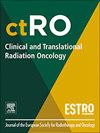Bulky non-small cell lung cancer treated with two-field robust proton lattice boost followed by conventional chemoradiation
IF 2.7
3区 医学
Q3 ONCOLOGY
引用次数: 0
Abstract
Despite advances in outcomes for non-small cell lung cancer (NSCLC) with the establishment of adjuvant immunotherapy as the standard of care, locoregional recurrence is still experienced by half of patients with progressive disease. We sought to integrate a novel pencil beam scanning (PBS) spatially fractionated approach into definitive management of bulky non-small cell lung cancer cases. Spatial fractionation via lattice or more commonly GRID has long been of interest as supplement to more conventional radiation regimens for bulky tumors, though requirements for plan robustness and concerns about single-field approaches have previously limited their integration into proton therapy practice. Here we present two cases of bulky NSCLC treated with a novel two-field partially robust PBS lattice boost of 12 Gy followed by standard conventional chemoradiation. Both patients experienced usual mild treatment related toxicities and remain with their bulky lesions controlled in field at more than a year out from treatment.
常规放化疗后双场强健质子点阵增强治疗体积大的非小细胞肺癌
尽管随着辅助免疫治疗作为标准治疗的建立,非小细胞肺癌(NSCLC)的预后有所改善,但仍有一半的进行性疾病患者出现局部区域复发。我们试图将一种新颖的铅笔束扫描(PBS)空间分割方法整合到大体积非小细胞肺癌病例的最终管理中。通过晶格或更常见的栅格的空间分割长期以来一直是对更传统的大体积肿瘤放疗方案的补充,尽管对计划稳健性的要求和对单场方法的担忧先前限制了它们与质子治疗实践的结合。在这里,我们提出了两例大体积非小细胞肺癌的治疗,采用了一种新的双场部分稳健PBS晶格增强12 Gy,然后是标准的常规放化疗。两名患者都经历了通常的轻度治疗相关毒性,并且在治疗后一年多的时间里,他们的大病灶仍然在现场得到控制。
本文章由计算机程序翻译,如有差异,请以英文原文为准。
求助全文
约1分钟内获得全文
求助全文
来源期刊

Clinical and Translational Radiation Oncology
Medicine-Radiology, Nuclear Medicine and Imaging
CiteScore
5.30
自引率
3.20%
发文量
114
审稿时长
40 days
 求助内容:
求助内容: 应助结果提醒方式:
应助结果提醒方式:


